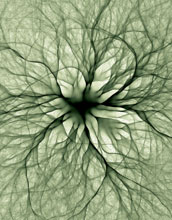Multimedia Gallery
Transport II
Transport II
"Transport II," from the Gallery of Eric J. Heller. Explanation of image, as taken from Heller Gallery: Transport II shows a theoretical simulation of the flow pattern for electrons traveling over a nanoscale landscape. The electrons are trapped in a sheet at the interface between two solids. Such sheets of electrons are of great importance in cutting edge electronics, forming the basis for sophisticated transistors. The total area seen here corresponds in size to a typical bacterium. The bumpy landscape which the electrons must negotiate is caused by the irregular arrangement of positively charged "donor" atoms in a layer lying just above the flat interface in which the electrons are traveling. The electrons are attracted to regions with more positive charges nearby, and since these charges are randomly arranged the electrons feel hills and valleys of repulsion and attraction. The electrons have more than enough energy to ride over the highest of the hills, but they are nonetheless slightly deflected this way and that as they pass by.
The cumulative effect of many such encounters with hills and valleys results in the pattern you see here. The branching seen here was not anticipated; it was thought that the flow would be more evenly spread out some distance from the center. This has significant implications for small electronic devices of the future. This image comes from a numerical simulation that closely approximated what is seen experimentally, using an extremely sensitive scanning probe microscope that can sample thousands of distinct places inside a space as small as a typical bacterium.
The experiments were performed in Robert Westervelt's lab at Harvard. Westervelt and his students managed to clearly image nanoscale electron flow for the first time. This image appeared on the cover of the 8 March 2001 issue of Nature, to accompany an article by Westervelt, Heller, and their research groups. About 200,000 individual electron tracks are shown here. Each electron, here treated as a classical point particle, was launched from the center and given a unique starting angle. The angles were evenly distributed over 360 degrees. Each track built up grayscale density to any pixels it passed by, thus the darkest areas depict domains where many electrons traveled. The existence of dark branches rather far from the launch point is surprising, as no valleys or other simple features of the landscape guide the branches. The electron tracks in Transport II are an excellent example of the wonderful way nature emulates herself in different contexts. The branching pattern is reminiscent of familiar natural forms.
Heller's work was included in the exhibit "Approaching Chaos," shown at the National Science Foundation (NSF) headquarters in Arlington, Va., July thru October 2002, as part of "The Art of Science Project." The Art of Science Project was conceived and implemented by a cross-directorate committee of NSF staff. Its purpose is to bring to NSF, original works of art that visually explore the connections between artistic and scientific expression.
This image is copyright and was included in the NSF Multimedia Gallery with permission from the owner. See "Restrictions" below regarding use of this image. [Research supported by Harvard's NSEC (NSF) grant.] (Date of Image: 2001)
Credit: Eric J. Heller, Harvard University
Special Restrictions: Copyright 2001 Eric J. Heller; not for publication without permission of author. Contact at mailto:slheller@comcast.net.
Images and other media in the National Science Foundation Multimedia Gallery are available for use in print and electronic material by NSF employees, members of the media, university staff, teachers and the general public. All media in the gallery are intended for personal, educational and nonprofit/non-commercial use only.
Images credited to the National Science Foundation, a federal agency, are in the public domain. The images were created by employees of the United States Government as part of their official duties or prepared by contractors as "works for hire" for NSF. You may freely use NSF-credited images and, at your discretion, credit NSF with a "Courtesy: National Science Foundation" notation.
Additional information about general usage can be found in Conditions.
Also Available:
Download the high-resolution JPG version of the image. (2.6 MB)
Use your mouse to right-click (Mac users may need to Ctrl-click) the link above and choose the option that will save the file or target to your computer.

